Funciones Circulares y Hiperbólicas
← Páginas
Contenidos
1 - Funciones Circulares
1.1 - Parametrización de la Circunferencia Unitaria
Nuestro objetivo inmediato antes de definir las funciones circulares es encontrar una forma de describir la circunferencia unitaria analíticamente. En lugar de usar la ecuación tradicional $x^2 + y^2 = 1$, la cual es conclusión inmediata del Teorema de Pitágoras y el hecho que cada punto en la circunferencia tiene la misma distancia hacia el origen, usaremos una parametrización de la circunferencia unitaria.
Así funcionará la parametrización: cuando se hace una cuerda del punto (-1, 0) a cualquier otro punto en la circunferencia unitaria, la cuerda debe cruzar el eje y en una coordenada y, $t$, por lo menos si es extendida lo suficiente. Las coordenadas del punto en la circunferencia unitaria donde va la cuerda resultan ser una función de $t$.
Proposición 1.1.1: La circunferencia unitaria se parametriza racionalmente por:
$$x = \frac{1 - t^2}{1 + t^2}$$
$$y = \frac{2t}{1 + t^2}$$
Donde $t$ es la coordenada $y$ del punto donde una cuerda de $(-1, 0)$ a algun punto en la circunferencia cruza el eje $y$.
Demostración: Sea O el origen. Dibuja una cuerda del punto P $= (-1, 0)$ a algun punto C en la circunferencia. Sea T el punto con la coordenada y $t$ donde esta cuerda PC cruza el eje y. Dibuja la linea CX perpendicular al eje $x$. Observe que los triángulos PTO y PCX son triángulos similares. En este caso, forman la misman pendiente. Eso significa que debe existir un factor de escala $s(t)$ de PTO a PCX. Tambien observe que PO = 1 debido a que forma un radio de la circunferencia.

El diagrama arriba muestra las longitudes de los lados de PTO antes de ser escaladas al triángulo PCX. Observe que $1+x = s(t)$ y que $y = s(t)\,t$. Aplicando el Teorema de Pítagoras al triángulo PCX nos dice que:
$$\begin{align*}
s(t)^2\,(1+t^2) &= (1+x)^2 + y^2\\
&= x^2 + 2x + 1 + y^2\\
&= 2x + 2\\
&= 2(x + 1)\\
&= 2s(t)\\
\Rightarrow s(t) &= \frac{2}{1+t^2}
\end{align*}$$
El resultado entonces es consecuencia de manipulaciones básicas. $\square$
Esto se puede generalizar inmediatamente para una circunferencia de cualquier radio con su centro en el origen simplemente multiplicando las coordenadas $x$ y $y$ por algun factor $r$, el cual será el radio. Es facil ver que esto nos da una circunferencia. Solo necesitamos revisar que se satisface la ecuación $(r\,x(t))^2 + (r\,y(t))^2 = r^2$.
Con esta parametrización en nuestra bolsa de herrimentas, nuestra siguente tarea será medir la circunferencia de los círculos y tambien encontrar sus area.s Las fórmulas para esto se describen mejor con respecto a los ángulos. Vamos a definir la medida de los ángulos usando las longitudes de arcos de la circunferencia unitaria. Las razones por esto se harán más claras despues. Recuerda que la fórmula para una longitud de arco es:
$$L = \int_{a}^{b} \sqrt{\left(\frac{dx}{dt}\right)^2 + \left(\frac{dy}{dt}\right)^2} dt$$
Para poder utilizar esta fórmula, primero necesitamos calcular las derivadas de cada función en la parametrización. Afortunadamente las funciones racionales no necesitan ningun truco especial. A pesar de esto, el resultado del cálculo es algo interesante.
Proposición 1.1.2: Las derivadas de las funciones que parametrizan racionalmente una circunferencia con radio $r$ son:
$$\frac{d(rx)}{dt} = -r\,s(t)\,y(t)$$
$$\frac{d(ry)}{dt} = r\,s(t)\,x(t)$$
Demostración: Ejercicio II. $\square$
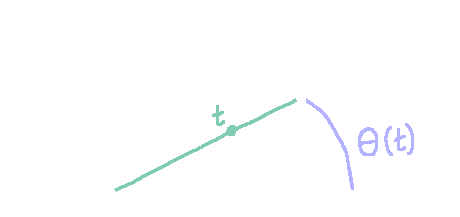
Esto nos perimitirá calcular la longitud de un arco de la circunferencia unitaria de 0 a un punto que se obtiene cuando se mete el valor $t_0$ en la parametrización racional. Esta longitud será anotada por $\theta(t)$. Usando la identidad $x^2 + y^2 = 1$, vemos que:
$$\begin{align*}
\sqrt{(dx/dt)^2 + (dy/dt)^2}
&= \sqrt{ s(t)^2\,y(t)^2 + s(t)^2\,x(t)^2} \\
&= s(t) \sqrt{y(t)^2 + x(t)^2} \\
&= s(t) \\
&= 2/({1 + t^2})
\end{align*}$$
Lo cual nos deja con:
$$\theta(t) = \int_0^t \frac{2\,du}{1 + u^2}$$
Ejercicios
Ejercicio 1.1.1: Complete la demostración Proposition I.
Ejercicio 1.1.2: Demuestra la proposición II.
Ejercicio 1.1.3: Muestra que $\theta$ es una función inyectiva de $t$.
1.2 - Areas y Circunferencias
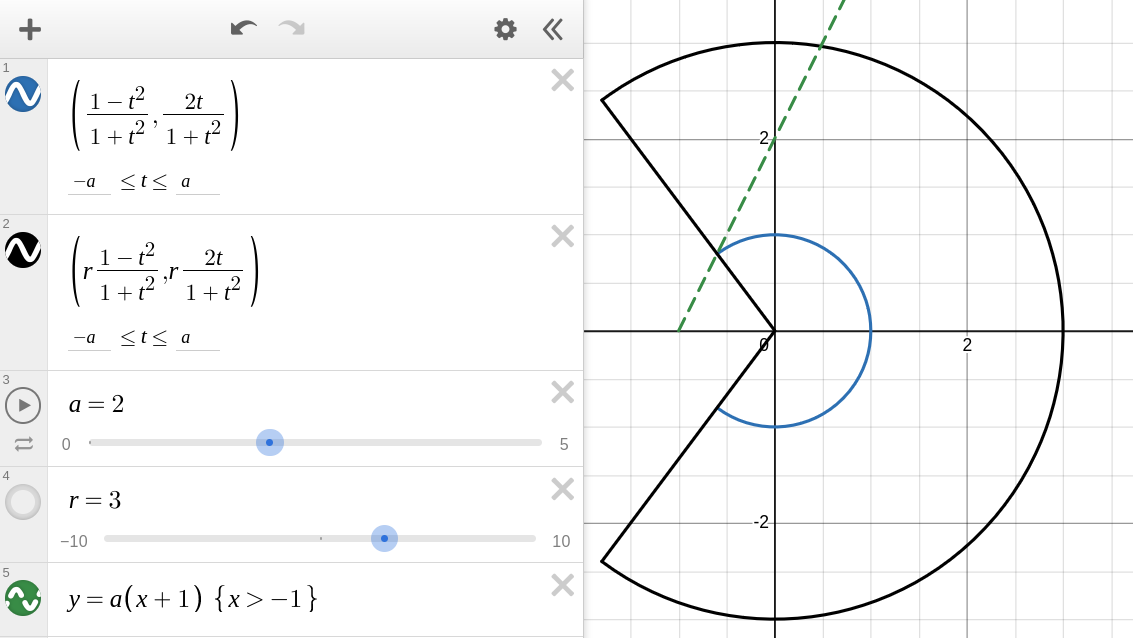
Observe que cuando nosotros escalamos la parametrización de la circunferencia unitaria por un factor $r$ igual al radio para parametrizar a un círculo general, el sector circular que se obtiene permitiendo que el parámetro varíe de $0$ a $t$ parece tener el mismo ángulo al sector circular en una circunferencia unitaria que se obtiene permitiendo la misma variación en el parámetro. Usamos esto para motivar la siguiente definición:
Definición: Given a particular radius, the circular sector of angle $\varphi \in \text{im } \theta$ is the portion of the circle obtained by letting the rational parametrization of the circle vary from $0$ to $t$, where $t \in \mathbb{R}$ satisfies $\varphi = \theta(t)$.
La existencia de un tal $t$ único se garantiza por el hecho de que $\theta$ es una función inyectiva. Ahora que tenemos esta definición, podemos dar las formulas precisas para la longitud de arco y el area de un sector circular.
Proposición 1.2.1: Sea $r \in \mathbb{R}^+$ la longitud del radio de un círculo y sea $\theta(t) \in \text{im } \theta$ donde $t \in \mathbb{R}$ un ángulo. Entonces la longitud de arco $L(t)$ del sector circular correspondiente es $r\theta(t)$, y el area $A(t)$ del mismo es $\frac{1}{2}r^2\theta(t)$
Demostración: Como antes, cuando calculamos $\theta(t)$:
$$\begin{align*}
\sqrt{(d(rx)/dt)^2 + (d(ry)/dt)^2}
&= \sqrt{ r^2\,s(t)^2\,y(t)^2 + r^2\,s(t)^2\,x(t)^2} \\
&= r\,s(t) \sqrt{y(t)^2 + x(t)^2} \\
&= r\,s(t) \\
\end{align*}$$
Luego con la fórmula de longitud de arco:
$$L(t) = \int_{0}^{t} rs(u)\,du = r \int_{0}^{t} s(u)\,du = r \theta(t)$$
Ahora utilizando la fórmula para la area de un sector paramétrico:
$$A = \frac{1}{2} \int_{a}^{b} x\frac{dy}{dt} - y\frac{dx}{dt} \,dt$$
Vemos que la area de un sector circular es:
$$\begin{align*}
A(t) &= \frac{1}{2} \int_{0}^{t} rx\frac{d(ry)}{du} - ry\frac{d(rx)}{du} \,du\\
&= \frac{1}{2} \int_{0}^{t} r^2 sx^2 + r^2 sy^2\,du\\
&= \frac{1}{2} \int_{0}^{t} r^2s\,du\\
&= \frac{1}{2} r^2 \int_{0}^{t} s\,du\\
&= \frac{1}{2} r^2 \theta(t)\\
\end{align*}$$
Lo cual es lo deseado. $\square$
Notice that these functions count areas and arcs under the x-axis as negative. This means that if we want to find the full area and circumference of a circle, we will need to either alter the range of integration to be from $-\infty$ to $\infty$, or multiply the functions we derived by 2 and then let $t \rightarrow \infty$. Doing the latter for area gives:
$$\begin{align*}
A &= \lim_{t \rightarrow \infty} 2A(t)\\
&= \lim_{t \rightarrow \infty} 2 \frac{1}{2} r^2 \theta(t)\\
&= r^2 \lim_{t \rightarrow \infty} \theta(t)
\end{align*}$$
And for circumference, we get:
$$\begin{align*}
C &= \lim_{t \rightarrow \infty} 2L(t)\\
&= \lim_{t \rightarrow \infty} 2r \theta(t)\\
&= 2r \lim_{t \rightarrow \infty} \theta(t)
\end{align*}$$
Recalling that the diameter of a circle is twice its radius, the equations above tell us that the ratio of a circle's circumference to its diameter is always the limit above. Thus, we define:
$$\pi = \lim_{t \rightarrow \infty} \theta(t)$$
Which means that the image of $\theta$ is the interval $(-\pi, \pi)$, and also leaves us with the classic formulas:
$$A = \pi r^2$$
$$C = 2\pi r$$
Exercises
Exercise 1.2.1: Prove that $\lim_{t \rightarrow \infty} \theta(t)$ exists and is less than 4.
Exercise 1.2.2: Using only properties of integration, explain why the integral representation of $\pi$ below agrees with the limit representation used above as a definition.
$$\pi = \int_{-\infty}^{\infty} \frac{du}{1 + u^2}$$
2.3 - Defining the Circular Functions
Intuitively, we define the circular or trigonometric functions as accepting as an input the length of an arc going counterclockwise along the unit circle from the point $(1, 0)$ and giving as an output the x and y coordinates of the point on which that arc ends. The picture of this definition is shown on the left.
This intuitive definition is usually presented without additional comment, which is usually fine for all practical purposes. However, our work in the previous act puts us in a good position to make this intuitive definition much more precise.
Since we now have a precise way to compute both angles and points on the unit circle in terms of the argument $t$ of the rational parametrization, we can define the circular functions using $t$:
Definition: The sine function $\sin: \mathbb{R} \rightarrow [-1, 1]$ and the cosine function $\cos: \mathbb{R} \rightarrow [-1, 1]$ are functions defined to be $2\pi$-periodic and satisfy the functional equations:
$$\sin(\theta(t)) = \frac{2t}{1+t^2}$$
$$\cos(\theta(t)) = \frac{1-t^2}{1+t^2}$$
This definition is conceptually identical to the unit circle definition. However, since it has more moving parts, it's worth stopping to make sure that we didn't screw anything up by putting it this way.
Recall that $\theta(t)$ is injective, and that its image is the interval $(-\pi, \pi)$. This means that for any real number $r \in (-\pi, \pi)$ there is some unique corresponding $t_0 \in \mathbb{R}$ such that $\theta(t_0) = r$.
This value $t_0$ may be plugged into the right side of the definitions if $r$ is plugged into one of the circular functions. Thus, the functional equation is a sensible way to define the circular functions over the whole interval $(-\pi, \pi)$.

Since the interval $(-\pi, \pi)$ has a length of $2\pi$, imposing $2\pi$ periodicity does not lead to any conflict as to which values the circular functions have in $(-\pi, \pi)$, and thus the functions are successfully extended to all real numbers. Well, almost. We still haven't defined the functions at inputs which are odd integer multiples of $\pi$. To rectify this, we observe that:
$$\begin{align*}
\lim_{\theta \rightarrow \pi} \sin(\theta) &= \lim_{t \rightarrow \infty} \sin(\theta(t))\\
&= \lim_{t \rightarrow \infty} \frac{2t}{1+t^2}\\
&= 0\\
\end{align*}$$
And analogously, that:
$$\begin{align*}
\lim_{\theta \rightarrow \pi} \cos(\theta) &= \lim_{t \rightarrow \infty} \cos(\theta(t))\\
&= \lim_{t \rightarrow \infty} \frac{1-t^2}{1+t^2}\\
&= -1\\
\end{align*}$$
So we simply take these to be the values of the circular functions at $\pi$ as part of the definition, as they are the values that keep the functions continuous. Periodicity takes care of all other odd integer multiples of $\pi$. With this final stipulation, the circular functions become defined as desired. We are now ready to prove the following important result:
Proposition 1.3.1: The sine and cosine functions are differentiable, with derivatives:
$$\frac{d}{d\theta} \sin(\theta) = \cos(\theta)$$
$$\frac{d}{d\theta} \cos(\theta) = -\sin(\theta)$$
Proof: The differentiability of sine and cosine follow from the fact that $x(t)$, $y(t)$, and $\theta(t)$ are all differentiable. Taking derivatives with respect to $t$ on both sides of the definition of sine, we can use the Chain Rule to compute:
$$\begin{align*}
\frac{d}{dt}\sin(\theta) &= \frac{dy}{dt}\\
\frac{d}{d\theta}\sin(\theta)\,\frac{d\theta}{dt} &= s(t)\,x(t)\\
\frac{d}{d\theta}\sin(\theta)\,s(t) &= s(t)\,x(t)\\
\frac{d}{d\theta}\sin(\theta) &= x(t)\\
&= \cos(\theta)
\end{align*}$$
This gives us the derivative over $(-\pi, \pi)$, and it extends to almost all of the reals by periodicity. The result is extended to odd integer multiples of $\pi$ by a theorem that says any function that is differentiable everywhere around a point is also differentiable at that point with matching derivatives (See Spivak's Calculus, citation will be provided later). The derivative of the cosine function is shown to be negative sine in a similar way. $\square$
Exercises
Exercise 1.3.1: Show that $\sin(\theta) \le \theta$ whenever $0 \le \theta$.
Exercise 1.3.2: Rigorously prove that $\lim_{\theta \rightarrow 0} \sin(\theta)/\theta = 1$. Hint: Use L'Hôpital's Rule :)
2 - Hyperbolic Functions
2.1 - Measuring the Hyperbola
Now that we've gotten the basic facts about the circular functions established, it is time to concern ourselves with the circular functions. This process is extremely similar to setting up the circular functions, and where it differs it is usually simpler. The unit hyperbola we are concerned with is described by the equation $x^2 - y^2 = 1$. As before, we can leverage a triangle similarity to come up with a rational parametrization for this curve. Everything is more or less analogous to the circular case, and the calculations are extremely similar, just that we have a minus instead of a plus.
It should be kept in mind that although not shown in the picture to save space, the hyperbola continues below the x-axis by reflection as described by the equation. Anyways, the triangle similarity is the same as before. Here is the diagram again for convenience.

The diagram above shows the lengths of triangle PTO before being scaled up to triangle PCX. In particular, note that $1+x = s(t)$ and $y = s(t)\,t$. Applying the Pythagorean Theorem to triangle PCX then gives us:
$$\begin{align*}
s(t)^2\,(1+t^2) &= (1+x)^2 + y^2\\
&= x^2 + 2x + 1 + y^2\\
\Rightarrow s(t)^2\,(1+t^2) - 2y^2 &= x^2 + 2x + 1 - y^2\\
&= 2(x + 1)\\
&= 2s(t)\\
\Rightarrow s(t)\,(1+t^2) - 2s(t)t^2 &= 2\\
\Rightarrow s(t)\,(1-t^2) &= 2\\
\Rightarrow s(t) &= \frac{2}{1-t^2}
\end{align*}$$
Basic algebra then once again leaves us with the following parametrization, which for $t \in (-1, 1)$ gives us the entire unit hyperbola to the right of the y-axis:
$$x = \frac{1+t^2}{1 - t^2}$$
$$y = \frac{2t}{1 - t^2}$$
And differentiation rules, as is left for the reader to check, tell us that:
$$\frac{dx}{dt} = s(t)y(t)$$
$$\frac{dy}{dt} = s(t)x(t)$$
Sadly, the calculations for arclength are not as nice as they were last time. However, keep in mind that in the unit circle, we had $A(t)=\frac{1}{2}\theta(t)$ (Proposition III), which will be useful when defining the hyperbolic functions. In the meantime, we can compute the area of a parametric sector as before without issue. Using $x^2 - y^2 = 1$, we get:
$$\begin{align*}
A(t) &= \frac{1}{2} \int_{0}^{t} x\frac{d(y)}{du} - y\frac{d(x)}{du} \,du\\
&= \frac{1}{2} \int_{0}^{t} sx^2 - sy^2\,du\\
&= \frac{1}{2} \int_{0}^{t} s\,du\\
&= \frac{1}{2} \int_{0}^{t} s\,du\\
&= \int_{0}^{t} \frac{du}{1-u^2}\,du\\
\end{align*}$$
Exercises
Exercise 2.1.1: Check the derivatives of $x$ and $y$.
Exercise 2.1.2: Show that $A(t)$ is an odd function.
Exercise 2.1.3: Show that $A(t)$ is bijective from $(-1, 1)$ to $\mathbb{R}$.
2.2 - Defining the Hyperbolic Functions
As previously mentioned, the integral of the arclength of a hyperbola isn't as nice it is in the circular case. However, not all hope is lost. Recall from Proposition 1.2.1 that in a unit circle, the area $A$ of the sector given by the angle $\theta$ is $\theta/2$. In other words, for a given area $A$, the corresponding angle is $2A$. We can use this to motivate the following definition:
Definition: The hyperbolic sine function $\sinh: \mathbb{R} \rightarrow \mathbb{R}$ and hyperbolic cosine function $\cosh: \mathbb{R} \rightarrow \mathbb{R}$ are functions defined to satisfy the functional equations, where $u(t)=2A(t)$:
$$\sinh(u(t)) = \frac{2t}{1-t^2}$$
$$\cosh(u(t)) = \frac{1+t^2}{1-t^2}$$
In the real numbers, the hyperbolic functions are nicer to deal with than the circular functions. There is no need to mess with the domain this time around. Everything is automatically taken care of. Also, this time it is actually possible to get an antiderivative for $2/(1-t^2)$ in the real numbers, and an explicit formula for the inverse of $u(t)$, as well as the hyperbolic functions themselves. However, this process is a bit cumbersome, so we will take a shortcut by using differential equations:
Proposition 2.2.1: The sine and cosine functions are differentiable, with derivatives:
$$\frac{d}{du} \sinh(u) = \cosh(u)$$
$$\frac{d}{du} \cosh(u) = \sinh(u)$$
Proof: Differentiability again follows from the fact that $x(t)$, $y(t)$, and $A(t)$ are all differentiable. Taking derivatives with respect to $t$ on both sides of the definition of sine, we can use the Chain Rule to compute:
$$\begin{align*}
\frac{d}{dt}\sinh(u(t)) &= \frac{dy}{dt}\\
\frac{d}{du}\sinh(u)\,\frac{d}{dt}2A(t) &= s(t)\,x(t)\\
\frac{d}{du}\sinh(u)\,s(t) &= s(t)\,x(t)\\
\frac{d}{du}\sinh(u) &= x(t)\\
&= \cosh(u)
\end{align*}$$
Which is essentially the same computation as last time. The same thing happens when computing the derivative of $\cosh(u)$, but because the derivative of $x(t)$ lacks a negative sign in the hyperbolic case, there is no negative in the formula for the derivative of $\cosh(u)$. $\square$
Proposition 2.2.2: These formulas for the hyperbolic functions hold:
$$\sinh(u) = \frac{e^u - e^{-u}}{2}$$
$$\cosh(u) = \frac{e^u + e^{-u}}{2}$$
Proof: Let $f(u) = \cosh(u) + \sinh(u)$. Notice that $f(0) = 1$. Compute derivatives to get:
$$\begin{align*}
f'(u) &= (\cosh(u) + \sinh(u))'\\
&= \cosh'(u) + \sinh'(u)\\
&= \sinh(u) + \cosh(u)\\
&= f(u)
\end{align*}$$
So $f$ satisfies the differential equation $f' = f$ with initial condition $f(0) = 1$. This has the unique solution $e^u$, which yields the equality $e^u = \cosh(u) + \sinh(u)$. Now, since $\sinh$ is an odd function and $\cosh$ is an even function, we can compute:
$$\begin{align*}
e^{-u} &= \cosh(-u) + \sinh(-u)\\
&= \cosh(u) - \sinh(u)
\end{align*}$$
Which gives us that:
$$\begin{align*}
e^u - e^{-u} &= \cosh(u) + \sinh(u) - (\cosh(u) - \sinh(u))\\
&= \cosh(u) + \sinh(u) - \cosh(u) + \sinh(u)\\
&= 2\sinh(u)
\end{align*}$$
$$\begin{align*}
e^u + e^{-u} &= \cosh(u) + \sinh(u) + \cosh(u) - \sinh(u)\\
&= 2\cosh(u)
\end{align*}$$
Which are the desired formulas. $\square$
Exercises
Exercise 2.2.1: Complete the proof of 2.2.2 by showing that $\sinh$ is an odd function and $\cosh$ is an even function.







